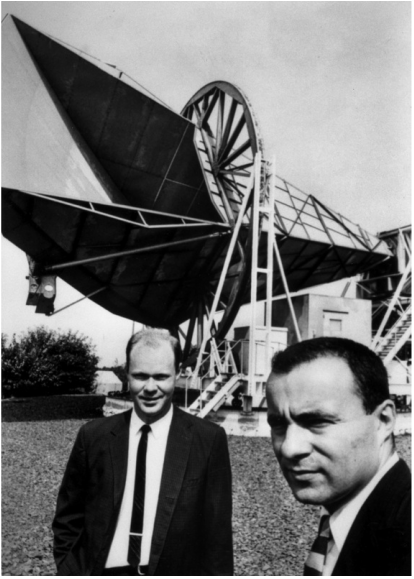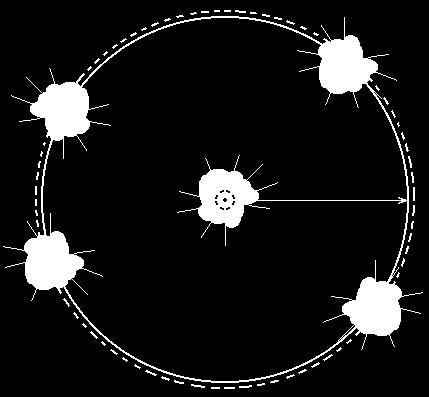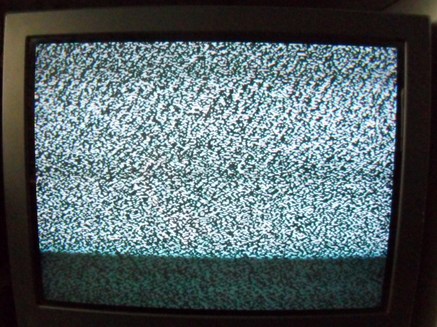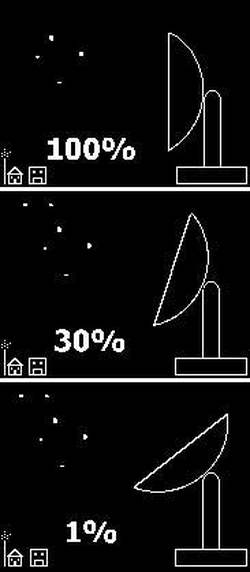 Penzias (right) and Wilson in front of the microwave antenna they used in Holmdel, New Jersey, U.S.A., to detect the first light.
Penzias (right) and Wilson in front of the microwave antenna they used in Holmdel, New Jersey, U.S.A., to detect the first light.
The Third Discovery
In 1964 Arno Allan Penzias (American radio astronomer, 1933–) and Robert Woodrow Wilson (American radio astronomer, 1936–) of Bell Laboratories were trying to improve the quality of microwave links for telephone communications. They wanted to reduce interference coming from the land and sky. Penzias and Wilson were not looking for the first light, but the microwave antenna they were using detected it coming from the fiery mixture soon after the beginning of the universe.
In 1964 Arno Allan Penzias (American radio astronomer, 1933–) and Robert Woodrow Wilson (American radio astronomer, 1936–) of Bell Laboratories were trying to improve the quality of microwave links for telephone communications. They wanted to reduce interference coming from the land and sky. Penzias and Wilson were not looking for the first light, but the microwave antenna they were using detected it coming from the fiery mixture soon after the beginning of the universe.
 Light spreading from five regions in the early universe.
Light spreading from five regions in the early universe.
Many people ask how we can still detect the first light after 13 820 million years. Let’s remember that the universe is very large. In the beginning light burst from every part of the universe, because the gamma rays collided everywhere. See the drawing for an explanation.
At the beginning all regions of the universe shone with light that went out in all directions. The Earth would later form in the middle of the central region. The first light that went out from that region has now reached the sphere shown as a solid circular line. Its distance from the Earth in light years is the number of years since creation.
The sphere was covered with shining regions (only four are shown). Some of their light was directed toward the future location of the Earth. Now their light is arriving, because light takes exactly the same time coming as going.
Around the solid sphere is a broken-line sphere, one light day farther from the Earth. From the broken line sphere light is also coming to the Earth, but it is still a light day away, at the small broken sphere. Tomorrow it will arrive. Thus the first light comes to us continuously from places that are farther and farther away.
At the beginning all regions of the universe shone with light that went out in all directions. The Earth would later form in the middle of the central region. The first light that went out from that region has now reached the sphere shown as a solid circular line. Its distance from the Earth in light years is the number of years since creation.
The sphere was covered with shining regions (only four are shown). Some of their light was directed toward the future location of the Earth. Now their light is arriving, because light takes exactly the same time coming as going.
Around the solid sphere is a broken-line sphere, one light day farther from the Earth. From the broken line sphere light is also coming to the Earth, but it is still a light day away, at the small broken sphere. Tomorrow it will arrive. Thus the first light comes to us continuously from places that are farther and farther away.
 The "Dance of the Dots" on an analog television set
The "Dance of the Dots" on an analog television set
Anyone can detect the first light with equipment as commonplace as a television set. Just turn it on and select a channel with no clear picture from any nearby television station. The picture will be a dance of black and white dots.
Some newer television sets recognize the lack of a strong signal and blank their screens. To see the dance of dots, use an older television set.
Seventy percent of the dots are electronic noise coming from TV stations too far away for clear reception, electric motors, and other human-made apparatus. Most of the rest of the dots are random emissions from the Sun, other stars, and distant galaxies. But one dot in a hundred came from beyond the stars. To Penzias and Wilson it was therefore the “background radiation.” It started coming before the stars existed. We now know that the source of the “background” was the first light in the universe. The original light, now cooled down to radio waves, strikes the TV antenna after traveling from the edge of the visible universe.
A television set doesn’t give a clear picture of the beginning of the universe. The interference is 100 times stronger than the original light.
The light comes from regions whose distance in light years from the Earth is equal to the number of years since the beginning.
Some newer television sets recognize the lack of a strong signal and blank their screens. To see the dance of dots, use an older television set.
Seventy percent of the dots are electronic noise coming from TV stations too far away for clear reception, electric motors, and other human-made apparatus. Most of the rest of the dots are random emissions from the Sun, other stars, and distant galaxies. But one dot in a hundred came from beyond the stars. To Penzias and Wilson it was therefore the “background radiation.” It started coming before the stars existed. We now know that the source of the “background” was the first light in the universe. The original light, now cooled down to radio waves, strikes the TV antenna after traveling from the edge of the visible universe.
A television set doesn’t give a clear picture of the beginning of the universe. The interference is 100 times stronger than the original light.
The light comes from regions whose distance in light years from the Earth is equal to the number of years since the beginning.
|
When Penzias and Wilson pointed their antenna along the ground it detected a noise level which we are here calling 100%. The noise dropped to 30% of the original level when the antenna pointed at the sky. In starless regions of the sky the noise drops to only 1%, but it never disappears.
|
